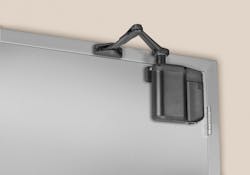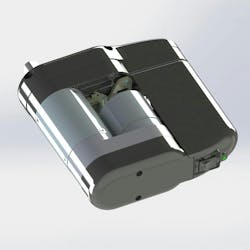This article originally appeared in the August 2024 issue of Security Business magazine. Don’t forget to mention Security Business magazine on LinkedIn and @SecBusinessMag on Twitter if you share it.
Energy harvesting refers to the process of capturing and converting ambient energy from the environment into usable electrical energy. When talking about the subject, most people think about technologies that leverage various sources, such as light, heat, vibration, motion, and radio frequency signals.
Solar panels, for example, convert sunlight into electricity; thermoelectric generators convert temperature differences into energy; piezoelectric materials generate electricity from mechanical vibrations; and electromagnetic generators capture energy from ambient radio frequency waves.
However, rarely does the conversation on energy harvesting shift to the potential of capturing energy from a moving door. People go through doors all the time, and there are so many doors in a typical facility. Capturing energy from a moving door uses energy harvesting technology to gather the mechanical energy generated during the door’s movement and convert it into electrical energy.
An electric motor mounted to the door takes the place of the typical surface-mounted hydraulic door closer and acts as a generator while also controlling the door. The electrical energy it generates can then be stored in a battery and used later to open the door for anyone needing the convenience – especially those with mobility challenges. This technology is particularly beneficial in environments with frequent door movement, such as retail stores, office buildings, or public facilities, and contributes to greater energy efficiency and sustainability.
Now that door energy harvesting technology is possible, it is being successfully deployed into commercial low-energy power door operator products. Designed for moderate to high-traffic manual opening applications that occasionally require powered operation, low-energy operators eliminate the need for an electrical power connection. The power savings potential, along with installation simplicity and overall cost-effectiveness, make the technology more feasible for more openings today.
That’s good news since low-energy power door operators have been growing in popularity for several years as building owners expanded accessibility for individuals with disabilities in various public facilities and spaces and compliance with the requirements of the Americans with Disabilities Act (ADA). In fact, the International Building Code (IBC) for 2021 includes a new provision that mandates automatic doors for entrances to public buildings. IBC 1105.1.1 stipulates that in facilities meeting building occupant load thresholds, accessible public entrances must have one door that is either a full power-operated door or a low-energy power-operated door. This means the code applies to a wide range of public places.
Low-energy operators are often used when the door will be opened manually by some users and automatically by others. The doors are subject to limitations on opening speed and force to limit the generation of kinetic energy and the potential for injury, and they must be operated by a “knowing act.” Because of these limits, most doors with low-energy operators are not required to have safety sensors, control mats, or guide rails.
A key advantage of a door energy harvesting device is that no electrical power is required. This simplifies installation and provides more versatility when it comes to choosing applicable locations.
To determine the most appropriate application for a low-energy door operator, manufacturers recommend using the 80/25 guideline, where a door is likely to get approximately 80-plus manual cycles and 25% or fewer automatic activations per day. Using the 80/25 guideline, a low-energy door operator can self-generate all the power it needs to keep a field-replaceable onboard battery pack charged for up to 12 years (or longer in some cases). A fully charged battery in some models has the capability to open a door up to 2000 times in a row.
As mentioned, a key advantage of a door energy harvesting device is that no electrical power is required. This simplifies installation and provides more versatility when it comes to choosing applicable locations. A product that can mount directly to the door eliminates any worry about header mounts, drop plates, or difficult installation configurations. There’s even a model that can mount to practically any commercial door up to 40 inches in width and 250 pounds in weight. It can automatically be tuned to the door size and its controller can operate within ANSI A156.19 and A117.1 standards once the door operator has been installed.
This eliminates the need to spend valuable time fine-tuning the unit. In addition, onboard diagnostics continually maintain control of door speed in wind-prone or other abusive environment conditions. But depending on site condition requirements, opening/closing speed, hold-open time, close check, and opening/closing force are still fully adjustable.
The National Electric Code requires that every three automatic door openers be powered by a dedicated 20 amp circuit. Since a low-energy power door operator typically requires no electrical connection, eliminating that cost and associated wiring could also be considered a direct savings of over $22 per year. While that may not initially sound like a lot of money, market studies show that about 80,000 low-energy door operators are sold annually. If every one of them used 0 external electrical energy, the estimated yearly savings would be in excess of $1.7M.
About the Author
Jay Vaitkus
With more than 25 years of industry experience, Jay Vaitkus, ASSA ABLOY Director of Business Development, is an expert in Pedestrian Door Solutions. Vaitkus holds degrees in Electrical Engineering Technology, Mechanical Engineering Technology, and Business Management. He is responsible for leading the team that created the Norton Rixson 5800 Series ADAEZ. https://www.assaabloydss.com/en

